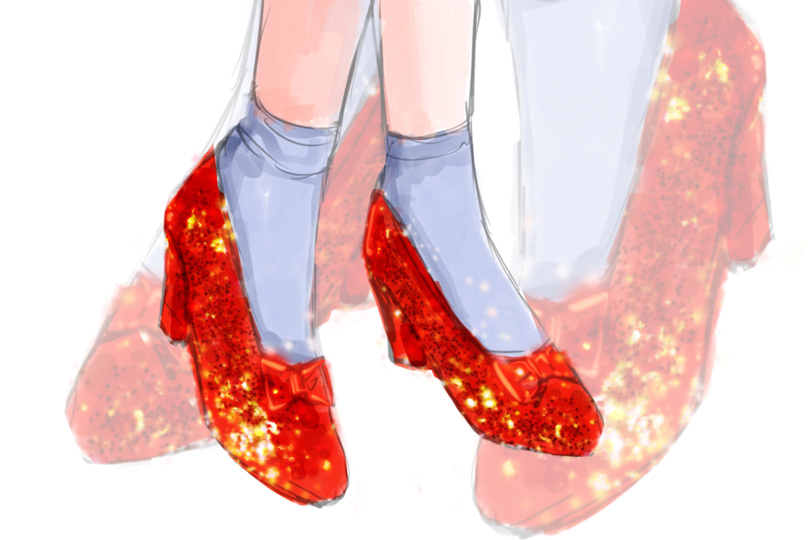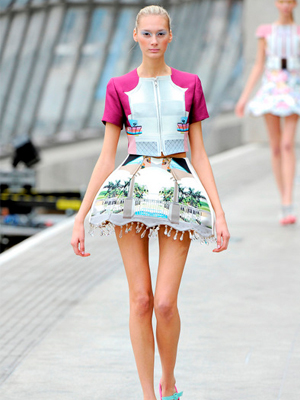Part of an ongoing series of 29Secrets stories, taking a deep dive into the history of legendary beauty products and iconic fashion moments…
By Christopher Turner
Illustration by Michael Hak
Dorothy Gale’s ruby red slippers from Victor Fleming’s 1939 classic The Wizard Of Oz are arguably one of the most famous movie props of all time, which is fascinating considering that for a number of years the shoes were practically forgotten about. From the 1930s to the 1960s, Hollywood movie studios failed to recognize the value of film memorabilia, and would often throw key props and costumes into the trash or repurpose them for other films. Of course, this all changed in 1970 when MGM organized its first auction, which included The Wizard Of Oz ruby slippers, bringing them back into the spotlight and putting a value on seemingly useless old movie props.
The slippers were originally supposed to be covered in red jewels, but the prototype turned out to be too heavy. Although it has never been officially confirmed how many pairs of ruby slippers were made for the movie, it’s believed that production worked with seven to 10 different pairs throughout filming…including one supposedly chewed up by Toto, and one with a slightly different design that never made it to screen. Today, only five of the original pairs survive, with one pair permanently on display at the Smithsonian’s National Museum of American History.
“The ruby slippers are among the most requested objects when visitors come to the museum,” says Ryan Lintelman, curator for entertainment at the Smithsonian. “One of the great national icons of America has become the ruby slippers.”
Eighty-five years on, Dorothy’s ruby slippers are so much more than a simple plot device in a beloved film. They have become synonymous with the magic of Hollywood and have achieved a status that few costume pieces will ever attain. Read on to learn more about the original shoes described in L. Frank Baum’s The Wonderful Wizard of Oz book (they weren’t red!), how the prop helped introduce Technicolor to the masses and where every single pair ended up. There’s even a crazy story with a mobster involved…a crime that has only just recently been solved.
Living in Technicolor
The Wizard of Oz was not the first colour movie, even though it is often remembered as the first (the first colour movie in film history was actually the 1914 feature-length film The World, The Flesh, and the Devil). However, the 1939 film was incredibly innovative because of its special effects and revolutionary use of Technicolor, which ultimately set a precedent for future movies.
The film was a critical success and was nominated for six Academy Awards, including Best Picture; it won Best Original Song (for “Over the Rainbow”) and Best Original Score. The film turned its young star, Judy Garland, into a Hollywood icon, and through the years the film has only become more popular: according to the US Library of Congress, it is the most-seen film in movie history.
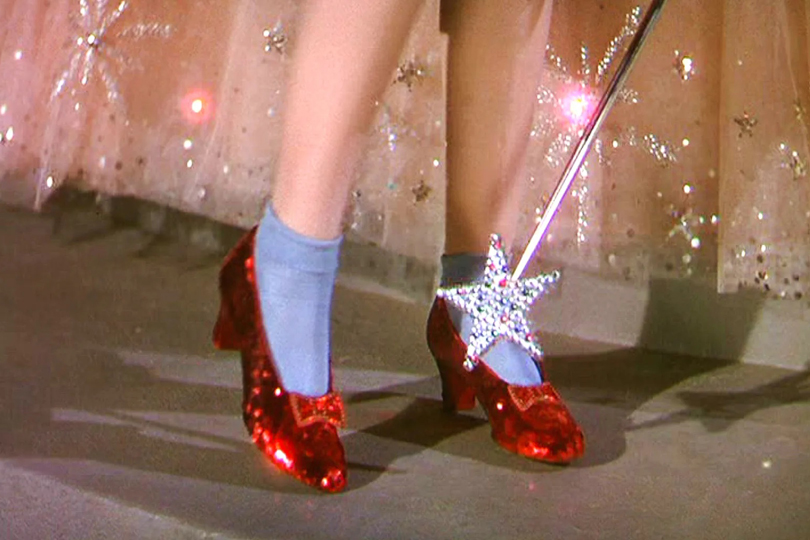
The shoes weren’t always red
Author L. Frank Baum published his children’s novel The Wonderful Wizard of Oz in 1900, about a Kansas farm girl named Dorothy who ends up in the magical Land of Oz after she and her pet dog, Toto, are swept away from their home by a cyclone. The ground-breaking success of that book led to 13 more books about Oz…and eventually to The Wizard Of Oz, the 1939 cinematic adaptation of the story starring Garland alongside Ray Bolger, Jack Haley and Bert Lahr.
Fans of the film surely cannot imagine Dorothy’s slippers being any colour other than ruby red but, originally, they weren’t—in Baum’s original book, they are silver. They are mentioned only in the first book in the series, and all Glinda (the Good Witch) tells Dorothy about them is that “there is some charm connected with them; but what it is we never knew.” Of course, in the end we discover they can transport the wearer anywhere they wish, and it is clear why the Wicked Witch of the West is obsessed with securing them for herself.
In keeping with the descriptions in the book, Dorothy’s shoes in the film were initially intended to be silver, and are described as silver in the earliest version of the script. However, MGM chief Louis B. Mayer thought the Technicolor production would benefit from the slippers being a more vibrant colour, so screenwriter Noel Langley changed things up. In a May 1938 draft of the script, the colour of the shoes was changed to ruby, reportedly to create a greater contrast with the yellow brick road and to take advantage of the eye-catching properties of Technicolor.
When production started, the shoes, originally intended to feature red jewels, were redesigned by MGM’s chief costume designer Gilbert Adrian with red sequins and felt-bottomed short block heels for more practical on-set use. The exception was the pair shown on the Wicked Witch of the East’s feet, which had different soles.
“There was something particular about the red and the sparkles,” says Turner Classic Movies host Alicia Malone. “That particular process made the red stand out even more. The fact that it sparkled, those sequins when she moved her feet, and the wand pointing towards her slippers—it’s just such a beautiful image [that] definitely stands out much more than silver slippers would have.”
Subsequent history
The fact that the slippers are still around to be enjoyed by the public today is something of a miracle. They were created during an era in Hollywood when film history was not considered something worth preserving and so movie studios were careless with old props, costume pieces, scripts and other materials, unaware of or indifferent to their increasing value as memorabilia.
The ruby slippers had been stored and forgotten in the basement of MGM’s wardrobe department until February or March 1970, when costumer Kent Warner found the five pairs of slippers while helping to set up a mammoth auction of MGM props and wardrobe.
One pair (size 5C) became the centrepiece of the MGM auction, and was purchased for $15,000 by a lawyer acting for an unidentified client. These are believed to be the pair on permanent exhibition in the Popular Culture wing of the National Museum of American History at the Smithsonian Institution in Washington, DC, though the donor insisted on anonymity.
According to the director of the museum, Dr. Brent Glass, “They were worn by Judy Garland during her dance routines on the Yellow Brick Road.”

A second pair of ruby slippers was owned by a Tennessee woman named Roberta Bauman (1922–2009), who won them for placing second in a National Four Star Club “Name the Best Movies of 1939” contest. Bauman held on to that pair until 1988, when she sold them at auction by Christie’s for $165,000. The winner of the auction was Anthony Landini, who worked with the Disney Company and started exhibiting them in the queue area for The Great Movie Ride that debuted in 1989. Landini auctioned the ruby slippers in 2000 for $666,000; the buyer was David Elkouby and his partners, who own memorabilia shops in Hollywood. Elkouby and Co. has yet to display the shoes.

So where are the other three pairs? They are all connected to costumer Kent Warner.
Depending on who you talk to, Warner was either a thief or someone who saved some priceless items that were destined for the trash bin. Rhys Thomas, author of The Ruby Slippers of Oz, an exposé of the Hollywood memorabilia industry, calls Warner “the Robin Hood of Hollywood.” Says Thomas: “It was because of him that some very high-quality pieces of Oz memorabilia exist today.”
The other three known surviving pairs Warner kept for himself, including the pair in the best condition (size 5B). Warner held on to that pair (also known as the “Witch’s Shoes”) until 1981, when he sold them to an unknown buyer through Christie’s East for $12,000. Two weeks after Landini bought his slippers, this pair resurfaced and was offered privately through Christie’s to the under-bidder of the Bauman shoes, Philip Samuels of St. Louis, Missouri. Samuels bought them for the same price that Landini had paid, $165,000. He has used his shoes for fundraising for children’s charities, as well as lending them to the Smithsonian when their slippers are being cleaned, repaired or (previously) on tour. In December 2011, auction house Profiles in History announced that this pair would be the highlight of its Icons of Hollywood auction. In an interview at the time, Joe Maddalena, head of Profiles in History, estimated that they would go for anywhere from $2 million to $3 million. On December 16, 2011, they were offered with a starting reserve price of $2 million, but did not sell. Ultimately, the Academy of Motion Picture Arts and Sciences—with the help of Leonardo DiCaprio, Steven Spielberg and other benefactors—purchased the slippers in February 2012 for their forthcoming museum; the price was not disclosed.

A second pair that Warner found in the MGM basement and kept for himself was an elaborate glittery curled-toe “Arabian” pair that was used for test and wardrobe shots, and that eventually ended up with actress and memorabilia preservationist Debbie Reynolds. This design was made to match the look of the Wicked Witch of the East, but was altered to match Dorothy’s style more closely as the primary wearer in the film. Reynolds acknowledged that she bought them from Warner for $300. Reynolds had amassed an extraordinary collection of cinematic ephemera over many decades, and had hoped to open her own memorabilia museum. That never panned out and in 2011, she was forced to sell the shoes for financial reasons; a private buyer paid $690,000 for them at an auction. Five years later, on December 28, 2016, Reynolds died after suffering a stroke while planning daughter Carrie Fisher’s funeral in Beverly Hills.
Some historians don’t include the “Arabian” pair when discussing the number of known pairs in existence today, but they were created for the film…even though they never made their way to the screen.
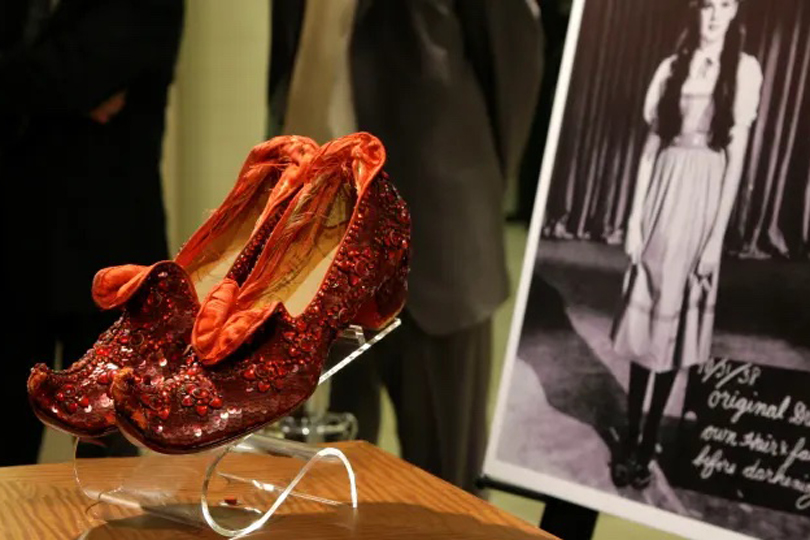
Warner sold the third pair that he had kept to Michael Shaw in 1970; Shaw took the sequined pair on the road, displaying them in malls and at Oz-inspired festivals. He also lent them to museums and used them to raise money for charity.
Shaw told Forbes that the size 5.5B shoes each had the name “Judy Garland” written in the upper left side of the lining and that they were used for closeup shots when Dorothy clicked her heels together. The scene accompanies one of the most famous lines from the movie: “Click your heels together three times and say, ‘There’s no place like home,’ and you’ll be there.”
“They were absolutely beautiful,” said Shaw, who handled them only while wearing gloves.
Those shoes were eventually lent to the Judy Garland Museum in her Minnesota hometown of Grand Rapids. However, they were stolen from the museum on the night of August 27, 2005, when a thief smashed through a window in the rear door of the museum, then broke through a Plexiglas holding case and made off with the slippers.
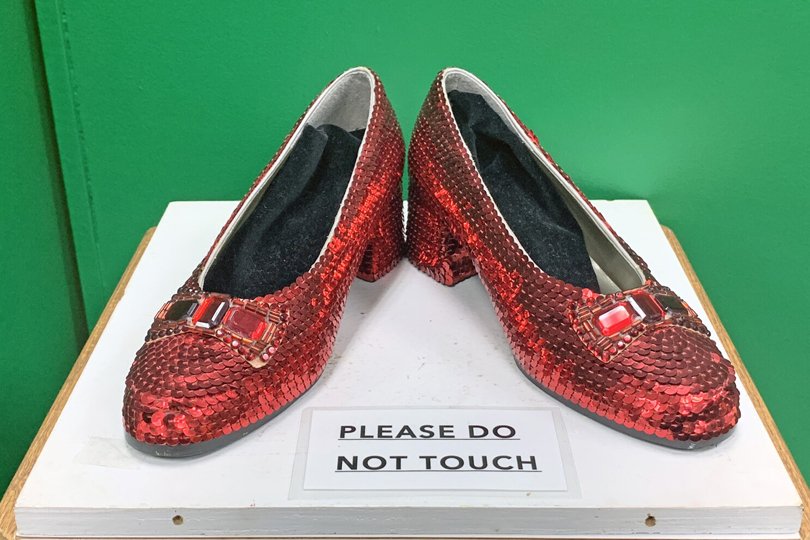
The ruby red slipper theft has been solved…with a confession from a mobster!
For years, there were no leads in the ruby red slipper case. In 2015, the Associated Press reported that an anonymous donor had offered a $1 million reward for information about the stolen slippers but, still, there was no news. Finally, on September 4, 2018, the FBI announced that, after a 13-year search, the stolen pair had been found and returned to the museum. The FBI recovered the shoes when someone tried to claim an insurance reward on them. However, no one was charged with stealing the ruby shoes until a federal grand jury indicted a Minnesota man on one count of theft on March 16, 2023.
The shoes had been stolen back in 2005 by Terry Jon Martin, a former mobster who had given up his life of crime but wanted to make “one last score.” Martin finally pleaded guilty in October 2023 to using a hammer to smash the glass of the museum door and display case, and taking the slippers.
“At first, Martin declined the invitation from an unidentified former mob associate to participate in the heist, but old habits die hard, and the thought of a ‘final score’ kept him up at night,” according to a sentencing memo written by Martin’s defence lawyer, Dane DeKrey. “After much contemplation, Terry had a criminal relapse.”
He added that Martin had never seen the movie and was completely unaware of the cultural significance of the sequin-encrusted heels. He believed that they were covered with real gemstones. The reason he thought that? The shoes had famously been insured for $1 million. When Martin discovered that the rubies were fake, DeKrey wrote, he gave the slippers to his old associate and told him he never wanted to see them again. The attorney said Martin never heard from the man again. Martin has refused to identify anyone else who was involved in the theft, and nobody else has ever been charged in the case.
On January 21, 2024, DeKrey and prosecutors jointly recommended that the judge sentence Martin to time served, because he was physically incapable of presenting a threat to society. He is currently in hospice care with a life expectancy of less than six months. He needs oxygen at all times because of his chronic obstructive pulmonary disorder and was in a wheelchair at his most recent court appearance. Even if he were sentenced to prison, his poor health might be grounds for a compassionate release.
Finally, on January 29, Chief US District Judge Patrick Schiltz accepted the recommendation of both sides and sentenced Martin to time served, as the loud hum of Martin’s oxygen machine echoed through the courtroom. Schiltz told Martin he probably would have sentenced him to 10 years in prison if it had still been 2005. The judge also accepted the recommendation from both sides that Martin should pay $23,500 in restitution to the museum, and ordered Martin to pay $300 a month.
“I certainly do not want to minimize the seriousness of Mr. Martin’s crime,” the judge said. “Mr. Martin intended to steal and destroy an irreplaceable part of American culture.”
According to John Kelsh, founding director of the Judy Garland Museum, the slippers that Martin stole were returned to Shaw and are being held for safekeeping by an auction house that plans to sell them after a promotional tour. Kelsh told reporters he doubts they will ever come back to Grand Rapids.
The ruby slippers from The Wizard Of Oz may not ever return to Grand Rapids, but they do have a home secured in pop culture history. And, to quote the film: “There’s no place like home.”
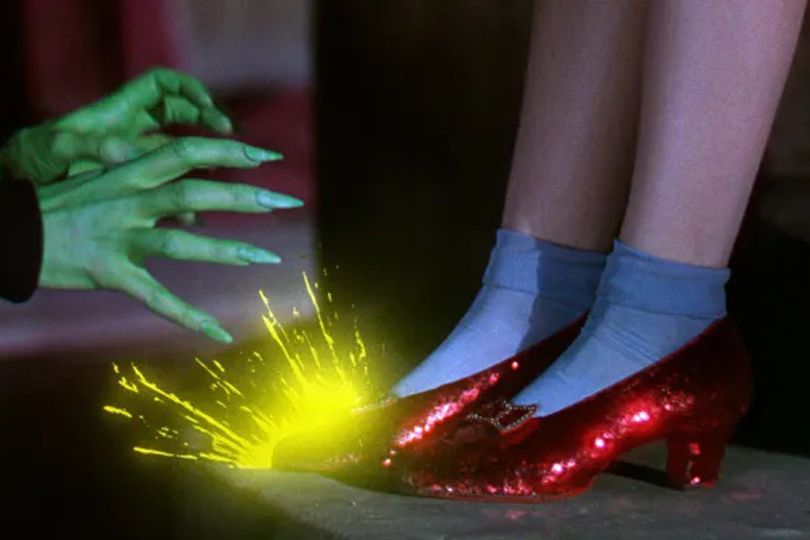
![]()
Want more? You can read other stories from our The Story Of series right here.

